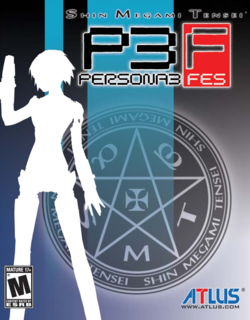School is about juggling studies, friends and fighting monsters
Persona 3: Fes puts the festive mood in Persona 3. It arrives with a cheaper price point, some new features, and an additional story segment known as the 'The Answer', a 30 hours plus additional game play which explains the aftermath of the main story (known as 'The Journey' in this version). If an invitation to experience this excellent game is ever required, there couldn't have been one greater.
Players take the role of a mysterious student who was recently transferred to Gekkoukan High School in a region where there is a heightened fear of the Apathy Syndrome, an illness which renders people into lifeless souls. Upon realising he possesses a far superior ability to command the powers of the Persona (an alternate being which lies within the deepest souls of certain people), the main character was quickly enlisted into SEES, a student-run group adamant on finding the truth behind this wide-spread disease. The source of their information is believed to lie in the depths of Tarturus, a mysterious tower that appears during the fine hour of between 12 o'clock and the beginning of each day.
Tarturus is where the dungeon crawling aspect takes place. Battles are trademark Shin Megami Tensei affair, demanding exploitation of enemies' weaknesses (while protecting the players'). It is a turn based mechanism with a twist. Party members are controlled entirely by A.I, although there are general directions that can be given out. While this reduces the commands to be made and thus make for fast-paced battles, the A.I is at times unreliable. This makes it even more punishing as the already difficult game will be over should the main character dies. With more than 200 floors to explore, it will take some time to fully exhaust the entire dungeon.
The calendar therefore plays an important role in the unique Persona 3 setting. The entire game takes place in one full academic year, where important dates such as exams and the all-important school vacation are carefully highlighted and thoroughly reminded of. Players will be free to make use of the time to their discretion, be it in studying or in boosting their popularity meter (it matters in school!). It has an element of "make your own adventure", although pockets of story lines are consistently inserted to provide some sense of directed progression.
Summoning the Personas requires a very deliberate action: shooting point blank in the head with a pistol (known as an 'Evoker'). Any fear of unwanted controversies such a sequence may create is ultimately unfounded, for it is more symbolic than it is realistic. The subtle message here could be that in deriving life's greatest strengths, death may well be the strongest catalyst, which is an element the story thoroughly explored. The main character has access of up to 12 Personas, many of which can be fused and improved in a secretive area known as the Velvet Room.
The occult influence is thoroughly reverberated in the entire game. Unlike the other Shin Megami Tensei titles however, Persona 3 relies on its acute sense of humour and cheerful demeanour to assuage the impact of such heavy and dark content. In strengthening the power of the Personas, it is necessarily to create what are known as the Social Links. By talking and spending time with others, relationships can be built. Peculiarly, this would have a direct impact on battles.
The dating simulation element is the final piece of the jigsaw puzzle that ultimately makes Persona 3 ticks. There is a fascinating variation of relationships that can be formed, built and maintained, helped only by the sheer believability of its many endearing characters. Belying the pixelated anime-inspired graphics are characters who players will immediately relate. It could be the class clown whom deep down suffers from an inferior complex, or the confident valedictorian who maintains her strong facets only as a barrier to protect her fragile personality; many of these encounters may just remind the player of someone he or she has once came across in real life.
While many games attempt to tell the story of how friendship would triumph difficulties (and ultimately failed to convince), Persona 3 lived by it. The repetitive nature of how the game progresses may pose a problem to some, but those are worthy efforts to unveiling the game's innate message. On a medium that is widely regarded as the anti-thesis to the personal touch that is readily losing its grips in today's society, Persona 3 succeeds in telling a moving story of love and friendships, yet remaining exceedingly relevant in its game play.

